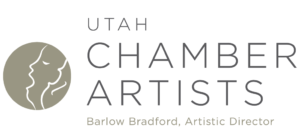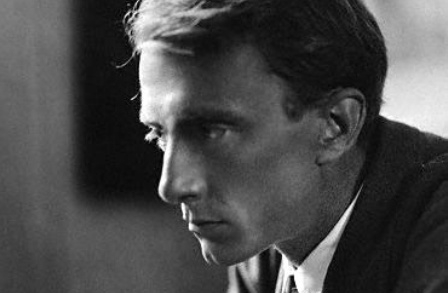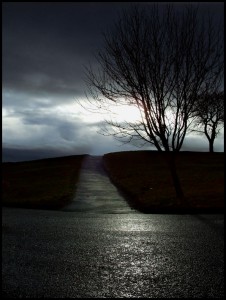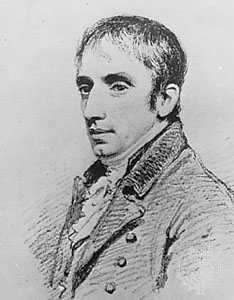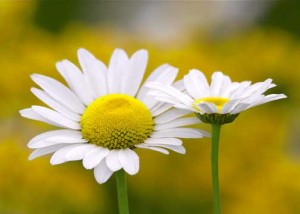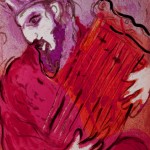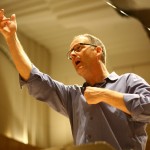Voicing Coalescence, pt. 2
After Rain (Petrichor)
Art, as the philosopher Suzanne Langer discovered, is the direct physical analog of human emotion, regardless of the medium. That, more than anything, explains what makes the marriage of word and music possible. It is not individual essences in the two forms that the composer seeks to unite, but the common essence that emerges when the marriage forms an inseparable amalgam of the two.
This is particularly true of Tarik O’Regan’s AFTER RAIN (PETRICHOR). “Petrichor” is a recently formulated word meaning “the smell of the earth after rain,” and its use as a title for O’Regan’s piece recalls a passage from the Book of 2 Samuel (23:3-4) purporting to be “the last words of David”:
He that ruleth over men must be just, ruling in the fear of God. And he shall be as the light of the morning, when the sun riseth, even a morning without clouds; as the tender grass springing out of the earth by clear shining after rain.ated word meaning “the smell of the earth after rain,” and its use as a title for O’Regan’s piece recalls a passage from the Book of 2 Samuel (23:3-4) purporting to be “the last words of David”:
We think of Randall Thompson’s “The Last Words of David” and Houston Bright’s “Rainsong” (“See how the rains do pour, as if forevermore.”)
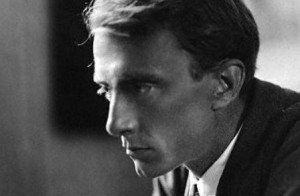
Edward Thomas, poet
Edward Thomas’s war poetry, like that of Wilfred Owen (the poet of Benjamin Britten’s War Requiem), grieves for the lost humanity and the futility that lies at the very root of war, the ravishment of all the senses and of nature, itself, “Where any turn may lead to Heaven / Or any corner may hide Hell / Roads shining like river uphill after rain.” Rain is the baptism, the cleansing that somehow makes sense of the brutally violated landscape and the torn lives left behind.
With these words as a preamble (random lines found on a slip of paper inside Thomas’s War Diary), the music seems to begin in midstream, as male voices moan above an unformed chord cluster, sounding the lament of the dead. Altos enter with the actual words, their voices ascending undramatically “to heaven,” before descending in the same way to “Hell.” A brief polyphony of women’s voices presents the last of the three lines, and then all come together in a dramatic climax, “after rain.”
The genius of O’Regan’s orchestration and choice of instruments (clarinet, harp, percussion and strings) now becomes evident, as he uses music as a vehicle to color and interpret Thomas’s poetry. In his setting of After Rain, the orchestration supports multiple images, musings of happy times past and the barely comprehensible present. Then, in It Rains, as the sun breaks through, shedding its light on the road and “what has been done,” it seems to reveal the color of death (“a border new / Of purple hue”).
Desolation and loneliness (embodied in the soprano solo) are presented in a solemn recitative marked by the “wind’s return.” Trees, shorn even of what dead leaves were left by late November, are “hard and bare,” save for “twelve yellow apples lovely to see / On one crabtree / And on each twig of every tree in the dell / Uncountable / Crystals both dark and bright of the rain / That begins again.” Whether Thomas intended a Christian symbolism is left for the individual listener to ponder.
A reprise takes us back to the first poem, It Rains, now given new meaning with the return of the lines, “Figures, suspended still and ghostly white, / The past hovering as it revisits the light.” Finally, in a reversal of roles, the women sing the moaning lament, as the men sing the words of the preamble, now as a coda, bringing together Heaven and Hell, and Roads shining like river up hill after rain.
Night Pieces
William Wordsworth, one of the first English Romantics, was also one of the great nature poets. His views on poetry and its purpose are aptly expressed in the following:
“I have said that poetry is the spontaneous overflow of powerful feelings: it takes its origin from emotion recollected in tranquillity: the emotion is contemplated till, by a species of reaction, the tranquillity gradually disappears, and an emotion, kindred to that which was before the subject of contemplation, is gradually produced, and does itself actually exist in the mind.”
Growing up in the Lake District of Northwest England, he was surrounded by mountains, streams, lakes, waterfalls, and all the other natural wonders of that celebrated region. The three Night Pieces selected by Redford in these settings reflect not only Wordsworth’s joy and personal identification with nature but also, especially in A Night Piece, something of disillusion, as demonstrated by the seeming indifference of humankind to the spiritual significance of nature.
Redford’s settings follow carefully the formal structure and elocution of the poems, and are good examples of the composer’s finding the “hue and fragrance of the thought,” without, it would seem, seeking to interpret the meaning beyond what is evident in their immediate content. The resulting rather mystic atmosphere captures the essence of the night and surrounds each of the poems in a rich mantle of sound. His transparent orchestrations (harp, winds, horn and strings), and a touch of Vaughan Williams in his harmonies, give a feeling of distance, yet intimacy, according well with the spirit of Wordsworth. The second half of ” The Sun Has Long Been Set” also has a tinge of Sitwellian tongue-in-cheek humor in its doggerel rhymes, reflected in the distinct change of musical style.
“The West Wind”
John Masefield’s The West Wind was the “irrigation” for one of Salt Lake City composer Robert Cundick’s best works. Composed for Ralph Woodward and the BYU Men’s Chorus, it is a remarkably fresh reading of the poem, full of energy and passion. The male chorus is propelled by a virtuoso piano accompaniment in perpetual motion, presumably the “west wind” itself. The urgency of the poem seems to derive from Masefield’s own experience as a sailor and later as an expatriot living in America. There are numerous opportunities for tone-painting in the poetic imagery, but the motive force for Cundick appears to have been the homeward call of the land, its intensity, universality, and inescapability.
John Masefield was born in Ledbury, Herefordshire, in 1878. He was orphaned at an early age and, after a brief period at the King’s School, Warwick, was educated aboard the Liverpool school-ship Conway. As an apprentice, Masefield sailed round Cape Horn in 1894; as a result of sickness, he was classified a Distressed British Sailor upon arrival in Chile. After convalescence in England he secured a new position in New York. Although he crossed the Atlantic, he never reported for duty. He later noted, “I was going to be a writer, come what might.” After a period of homelessness and vagrancy, bar and factory work in America, Masefield returned to England in 1897. His first published poem appeared in a periodical in 1899. The friendship of W.B. Yeats provided encouragement, and in 1902 Salt-Water Ballads was published. A distinguished literary career followed, with work across a broad range of genres. Masefield was appointed poet laureate in 1930, and awarded the Order of Merit in 1935. He died in 1967; his ashes are buried in Poet’s Corner, Westminster Abbey. It is interesting to note that Masefield is, by accident or design, the fourth poet featured in tonight’s program to have been commemorated in the Poet’s Corner of Westminster Abbey, the other three being Edward Thomas, William Wordsworth, and William Shakespeare.
 “When Daisies Pied”
“When Daisies Pied”
“When Daisies Pied,” by John Rutter, is composed to a text that concludes Shakespeare’s Love’s Labour’s Lost. The setting is the last piece in “Birthday Madrigals” written for the occasion of George Shearing’s 75th birthday.
from the Shakespeare –
When daisies pied, and violets blue, And lady-smocks all silver-white
And cuckoo-buds of yellow hue Do paint the meadows with delight,
The cuckoo then, on every tree, Mocks married men; for thus sings he,
“Cuckoo; Cuckoo, cuckoo”: Oh word of fear,
Unpleasing to a married ear!
When shepherds pipe on oaten straws, And merry larks are plowmen’s clocks,
When turtles tread, and rooks, and daws, And maidens bleach their summer smocks,
The cuckoo then, on every tree, Mocks married men; for thus sings he,
“Cuckoo; Cuckoo, cuckoo”: Oh word of fear,
Unpleasing to a married ear!
“April in Paris”
Dr. Bernell Hales was, for many years, a much-beloved professor in the Music Department of the University of Utah. A wonderful musician and conductor, he was a mentor and friend to many talented students over the years, including our own Barlow Bradford, who, over the years remained close and has been an untiring champion of Hales’ music. Dr. Hales arranged many popular tunes for his elite singing group [name?]. His suave, sophisticated style can be heard in old favorites such as tonight’s performance of Vernon Duke’s “April in Paris,” from the 1932 musical, Walk A Little Faster. No finer example of American song exists in the entire literature of popular music. The lyrics were written by E. Y. “Yip” Harburg, one of Broadway’s most prolific and distinguished lyricists. He wrote the words to more than 600 songs, including such classics as “Somewhere Over the Rainbow,” from The Wizard of Oz, “It’s Only a Paper Moon,” and, of course, “April in Paris.” It’s hard to imagine a finer wedding of words and music.
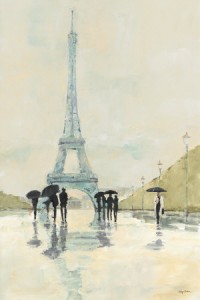 I never knew the charm of spring
I never knew the charm of springI never met it face to face
I never knew my heart could sing
I never missed a warm embraceTill April in Paris, chestnuts in blossom
Holiday tables under the trees
April in Paris, this is a feeling
That no one can ever repriseI never knew the charm of spring
I never met it face to face
I never knew my heart could sing
I never missed a warm embraceTill April in Paris
Whom can I run to?
What have you done to my heart?
